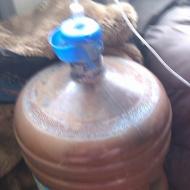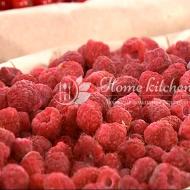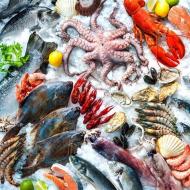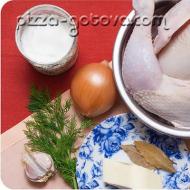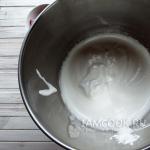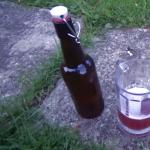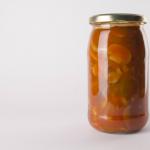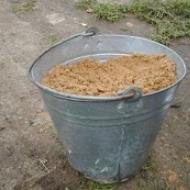
Recipes for wine from grapes with water. How many grapes are required per liter of wine? How much wine is obtained from 10 kg of grapes
Going once again for products for jam, compotes, pickles, or just making supplies, most of the population takes a bucket with them. Therefore, it would be useful to find out how many kilograms of products fit in a bucket.
Potato has long been a popular "independent" product in our menu, as well as an indispensable component of many dishes. Therefore, the purchase of this garden food product is made not in kilograms, but in buckets or even bags. How much does a bucket of potatoes weigh? This question is often asked by buyers in the market, stocking up potatoes for future use for several months at once. Today we will learn about the weight of one "standard" bucket of potatoes, as well as other products and materials.
A 10 liter bucket weighs 6.5 - 7.5 kg, and a 12 liter bucket weighs up to 10.3 kg.
The mass of a bucket of potatoes, first of all, depends on the volume of the container itself. For example, in a bucket of 10 liters, you can pour 6.5 - 7.5 kg of potatoes. The value of this indicator is also affected by the fullness of the bucket - if the seller generously poured potato tubers with a “slide”, then the total weight will increase.
In addition, the material from which the bucket is made is taken into account. So, in an enameled bucket, the mass of an empty container is added to the weight of the potatoes - about 2 kg. And the weight of potatoes poured into a galvanized bucket with a capacity of 10 liters will increase by about 1 kg.
About 10.3 kg of medium-sized tubers can be poured into a 12-liter bucket, without taking into account the mass of the container.
How much does a bucket of potatoes weigh? Another decisive factor is the size of the tubers in the bucket. More small potatoes will fit into the bucket than large ones, and the filling of the space will be more dense. But large, elongated potatoes leave a lot of free space in the bucket.
For comparison: if you pour small and large potatoes into two identical containers and compare the mass, then in the first case the bucket will be a little heavier.
How much does a bucket of apples weigh?
The mass of a 10-liter bucket of apples is approximately 4.3 - 5.8 kg. It is noteworthy that compared to potatoes, apples are a fairly light product. And, if compared with a bucket of sand, then a bucket of apples is more than 2.5 times lighter.
How much does a bucket of mushrooms weigh?
A bucket of mushrooms weighs from 2.5 to 10 kg. depending on the type of mushroom.
Mushrooms can differ not only in taste and general appearance, but also in density. Different types of mushrooms have unequal density, which determines their weight. For example, let's take a ten-liter container as a unit of measure. A bucket of chanterelles weighs 2.5 kg, honey mushrooms - 3 - 4 kg, mushrooms - 4 kg, porcini mushrooms - 4 - 6 kg, butter - 10 kg. So, of these species, chanterelles are the lightest, and butter mushrooms are the heaviest mushrooms in weight.
How much does a bucket of cucumbers weigh?
Of course, cucumbers come in different sizes and shapes. Usually, there are much more small cucumbers in a bucket than large ones. And so, a full ten-liter liter bucket of cucumbers weighs 6-7 kilograms.
How much does a bucket of strawberries weigh?
During the season of harvesting and conservation, many housewives ask a similar question. Indeed, in some recipes for strawberry jam, jam or compote, the unit of measurement is kilograms. Therefore, it is worth remembering that one bucket (10 l) with strawberries can weigh 6 - 8 kg.
 A bucket is a popular measure for many products and materials. If we talk about sand, then its weight directly depends on the type and quality. For example, a bucket of sand for construction work with a volume of 10 liters will weigh about 16 kg, and a 12-liter bucket will weigh about 18 - 20 kg. For dry river sand, these figures will be 15.2 kg and 18.3 kg, respectively. But the weight of a bucket (10 liters) of wet sand is already a little heavier - about 18.1 kg.
A bucket is a popular measure for many products and materials. If we talk about sand, then its weight directly depends on the type and quality. For example, a bucket of sand for construction work with a volume of 10 liters will weigh about 16 kg, and a 12-liter bucket will weigh about 18 - 20 kg. For dry river sand, these figures will be 15.2 kg and 18.3 kg, respectively. But the weight of a bucket (10 liters) of wet sand is already a little heavier - about 18.1 kg.
A bucket of sand 10 liters weighs about 16 kg, and a 12 liter bucket weighs 18 - 20 kg.
Sand mixed with dust, poured into a ten-liter bucket, will weigh about 20.7 kg, which is about four kilograms heavier than building sand. The same difference in weight will be observed if we weigh and compare 12-liter buckets with sand of these types.
In this article we will discuss the topic of making wine at home. Here are two easy recipes.
Since ancient times, wine has been famous for its beneficial properties. Wine not only relaxes, relieves stress and cheers up, but is also a valuable healing drink, because it contains vitamins from grapes, and additional beneficial substances are produced during fermentation. So wine normalizes blood pressure, helps with anemia and improves appetite, and even helps to eliminate radionuclides from the body. Wine is part of various dishes, which gives them a more piquant and pleasant taste. However, all these statements are true only in relation to real wine.
Where can one find such wine in our time, when so many fakes and various surrogates are sold in stores and on the market? One of the ways to enjoy real wine is to buy it only from trusted sellers who supply it directly from manufacturers, whether they are Russian or foreign producers, for example, from famous French winemakers, etc. But not everyone has such an opportunity, because. And this wine is not cheap at all. There is another way, it is much less expensive, but somewhat more laborious, however, if you like to cook or do household chores, then it will seem quite simple to you, and besides, it will allow you to spend your time usefully. So, the second way to drink a glass of another real wine for a holiday or on occasion is to cook it yourself at home.
 There are many recipes for making homemade wine. Which one to stop? It all depends on your tastes and preferences. We offer in this article two of the most easy-to-use recipes. According to one of them, the wine is aged for 2-3 months in large bottles in the cellar at a temperature of plus 5 degrees, but the disadvantage of this method of preparation is strict adherence to the temperature regime, since not everyone will be able to maintain such a regime, in this case we will give one more an easier recipe for making homemade wine.
There are many recipes for making homemade wine. Which one to stop? It all depends on your tastes and preferences. We offer in this article two of the most easy-to-use recipes. According to one of them, the wine is aged for 2-3 months in large bottles in the cellar at a temperature of plus 5 degrees, but the disadvantage of this method of preparation is strict adherence to the temperature regime, since not everyone will be able to maintain such a regime, in this case we will give one more an easier recipe for making homemade wine.
First, let's say a few words about grapes, the Isabella variety is best suited for making homemade wine, you can take both wine and table varieties. Both white and red grapes, or a mixture of both, are also suitable.
In general, the technology for preparing this ancient drink is not particularly complicated and almost everyone can master it. The most responsible and painstaking part of the work is to separate the berries from the gronoks (brushes) and sort out the grapes, here you also need to make sure that dry or spoiled berries do not get in, because. they will spoil the whole taste of future wine.
 What else needs to be prepared before proceeding directly to the process of making wine? You will need large glass bottles of 5, 10 or 20 liters if you decide to make wine according to the second recipe. Or if you use the first, more affordable recipe, then 3-liter or 5-liter cans will suffice. You will also need lids for jars or bottles. For bottles, you also need to prepare special lids and tubes through which excess gas will escape.
What else needs to be prepared before proceeding directly to the process of making wine? You will need large glass bottles of 5, 10 or 20 liters if you decide to make wine according to the second recipe. Or if you use the first, more affordable recipe, then 3-liter or 5-liter cans will suffice. You will also need lids for jars or bottles. For bottles, you also need to prepare special lids and tubes through which excess gas will escape.
Now let's decide on the number of grapes. It all depends on how much wine you want to end up with. But in any case, the proportion will be as follows, we take at the rate of 1–1.5 kg of grapes for each liter of wine. Accordingly, if you need 5 liters of wine at the exit, we take 5 kg of grapes +/- 1–2 kg, and also for 10 liters - 10 kg, for 20 liters of wine - 20 kg, etc., getting the same 10 and 20 liters.
 To begin with, until you master the technology of preparing a drink, you should not try to prepare a large volume, so let's try to prepare 10 liters of wine as a first step.
To begin with, until you master the technology of preparing a drink, you should not try to prepare a large volume, so let's try to prepare 10 liters of wine as a first step.
First recipe
So, we went through the grapes, separated the berries from the gronok. Now we need to cook pulp from it. In other words, just crush the grapes. To do this, we put it in an enamel bowl, you can take a 10 liter enamel bucket, and use a regular potato crush to mash the berries. You can do this with your hands, wearing gloves. Another important point to consider is that the berries cannot be washed, otherwise fermentation will not occur.
 After that, the container with the resulting pulp should be covered with gauze on top and left in a warm place for fermentation for about 4-5 days. Also, twice a day, the fermented mass must be mixed with a wooden spatula.
After that, the container with the resulting pulp should be covered with gauze on top and left in a warm place for fermentation for about 4-5 days. Also, twice a day, the fermented mass must be mixed with a wooden spatula.
When the pulp rises, it should be squeezed out. To do this, transfer the crushed berry in parts into a colander to drain the juice, and then squeeze it through cheesecloth.
Now we pour pure grape juice into prepared three-liter jars and add sugar, for 10 kg of grapes we need 2.5–3 kg, and mix.
We put on medical gloves on the neck of the cans, after rinsing them with water, we pierce several holes in the fingers of the gloves and tightly tighten the neck with rubber bands.
Next, the wort must be given, as it should be fermented. We leave the jars for 2-3 weeks indoors at room temperature and monitor the gloves. At the beginning of fermentation, they puff up and the more they deflate, the closer the wine is to readiness.
The readiness of wine is also determined by how light it becomes. Clarified wine, as soon as the yeast settles in it and gurgling stops, you need to carefully strain into clean prepared bottles, while you must carefully monitor that the yeast does not get into a new container. Then tightly cork the wine bottles with corks.
 Finally, the last step. Wine should be allowed to stand in a cool place for another month, and it will be possible to taste.
Finally, the last step. Wine should be allowed to stand in a cool place for another month, and it will be possible to taste.
Second recipe
According to the second recipe, the cooking technology is somewhat different. We put the prepared sorted grapes into a large enameled dish, for example, a 60-liter saucepan and immediately crush. It is necessary to crush immediately so that the fermentation of the berries does not begin ahead of time.
Then we separate the cake, and pour the resulting juice into large glass 10- and 20-liter bottles. The bottles now need to be corked with special lids and tubes inserted through which carbon dioxide will escape. We lower the other end of the tube into jars of water. Please note that the bottles should not be filled to the brim, but by about 2/3, so that the wine has a place where to “play”. Remember also that the lids must be airtight, otherwise you will end up with wine vinegar instead of wine. One way to ensure such tightness is to close the lids with plasticine.
 Next, we make the bottles in the cellar with a temperature of +5 degrees. It will take 2-3 months to stand the blame. During this period, you should check whether the water in the jars gurgles, and from time to time rinse them and change the water. If the room temperature is above +5, then fill the bottles by about half, not a third. Throughout this time, the wine will slowly “play” and acquire its own unique taste.
Next, we make the bottles in the cellar with a temperature of +5 degrees. It will take 2-3 months to stand the blame. During this period, you should check whether the water in the jars gurgles, and from time to time rinse them and change the water. If the room temperature is above +5, then fill the bottles by about half, not a third. Throughout this time, the wine will slowly “play” and acquire its own unique taste.
By the end of the period, the wine almost stops fermenting, and all the turbidity and foam settle to the bottom of the bottles. When the fermentation process is almost complete, you can pour the wine into small bottles. As a result, you will get homemade dry wine with a strength of no more than 5%.
If you prefer a sweeter and stronger wine, then in order to get a drink that is more saturated in taste and other parameters, you will have to be patient for about another month. So, to get a sweeter and stronger wine at the output, we perform the following simple operations. Carefully pour the contents of the bottles into a large container, leaving all the sediment at the bottom of the bottles. Then we add sugar to our unfermented wine, at the rate of 1–1.5 kg per 10 liters of drink, and mix thoroughly until the sugar is completely dissolved. We wash and dry the bottles. Then again pour wine into them and cork with the same lids. So, the wine should stand for another month.
 After a month, pour the finished wine into wine bottles and you can try this unique natural and healthy drink. The wine received a sweeter rich taste and a strength of about 10–13%. Such a drink can be proudly served to guests or enjoyed during family holiday dinners and celebrations.
After a month, pour the finished wine into wine bottles and you can try this unique natural and healthy drink. The wine received a sweeter rich taste and a strength of about 10–13%. Such a drink can be proudly served to guests or enjoyed during family holiday dinners and celebrations.
Alexander Gushchin
I can't vouch for the taste, but it will be hot :)
Content
The secrets of winemaking can be studied for almost years. Although everyone can easily learn this art. From the first time, you may not get a masterpiece worthy of world exhibitions, but a home-made drink will be no worse than a store-bought one. Want to try? Then learn simple recipes with photos describing how to make wine from grapes at home.
How to cook
Homemade wine requires three main ingredients. This list includes:
- grape;
- sugar;
- water.
The last component is not used in all recipes for making homemade wine. It is added only if the grape juice is very sour and even reduces the cheekbones. In other cases, dilution with water only worsens the taste of the drink. Making wine from grapes at home begins with the harvest and processing of the crop. On the clusters, there must be wild yeast necessary for fermentation. To do this, you need to collect fruit after 2-3 days of dry weather. If the grapes are purchased, then the berries cannot be washed.
Making homemade wine after processing the crop includes three stages. Step-by-step instructions on how to make a drink can be described as follows:
- Getting pulp. It is an intermediate product of winemaking and is a mass of crushed grapes. The combs do not have to be removed, but the wine with them will be slightly bitter.
- Wort separation. This stage begins 3-5 days after receiving the pulp. It is from this that the must stands out - unclarified grape juice. This is already wine, but young and not started to ferment.
- Fermentation. During this stage, the wine yeast multiplies and converts the fruit sugar from the grapes into alcohol. The must here is separated from the pulp, poured into a working glass container and closed with a stopper with a water seal or a medical glove. At the same step, you can sweeten homemade wine.
Fermentation time
Many factors influence the fermentation of the drink - temperature, amount of sugar and yeast activity. Therefore, there is no exact answer to the question of how much homemade grape wine plays. This process may take around 30-90 days. Fermentation is divided into three stages:
- Elementary. Yeast fungi begin active reproduction.
- Stormy. Bacteria finish multiplying, occupying the entire volume of the wort. The first couple of days it actively hisses and foams. How long does the wine ferment in this phase? It can play from 0 to 100 days, depending on the desired strength of the drink.
- Quiet. The wort calms down, there are already very few bubbles. The foam settles, and fermentation takes place in the lower layers. The duration of this phase is determined by the period of processing by fungi of all sugar into alcohol.
Amount of sugar
Approximately 1% of the alcohol in the finished drink is provided by 2% of the sugar in the wort. The sugar content of grape varieties common in central Russia rarely exceeds 20%. They will make a drink with a strength of about 6-7%, a maximum of 10%. In addition, the sweetness of the drink will be zero, and the taste will be sour-astringent. The sugar content of the wort should not exceed 15-20%, otherwise the yeast will stop fermenting.
So how much sugar is needed in grape wine? The product is added fractionally after the juice tastes sour. For each liter, 50 g of granulated sugar is required. They are diluted in 1-2 liters of drained wort, then sent back to the bottle. Do this once every 3-4 days in the first 2-3 weeks of fermentation. When the juice no longer tastes sour, it means that there is already enough sugar and no more need to be added.

Proportions
In the classic version, 10 kg of grapes are taken. If each requires about 100-200 g of sugar, then in general you will need 1-2 kg. In rare cases, water is needed. It is taken at the rate of 500 ml per 1 liter of juice. At the end, the wine is made semi-sweet, sweet or fortified. There is another option - a liqueur drink. The table contains the proportions of homemade wine from grapes in relation to the content of alcohol and granulated sugar.
sweet
The content of sugar and alcohol in sweet homemade wine should be between 12-18% and 16-20%. The acidity does not exceed 0.8%. It is better to make such a drink from blue grapes or use nutmeg varieties. Sugar should be added at the rate of 50-100 g per 1 liter of juice. It's in the fermentation stage. Already at the end, you can make sweet homemade wine to your liking by adding a little more sugar.
Fortified
According to the traditional recipe, fortified grape wine is prepared at home with the addition of sugar and alcohol or vodka. The strength of the drink will depend on their quantity. By adding fruits or berries to the grape must, you can get different types of fortified homemade wine - vermouth, port or sherry. The proportions for them are approximately the following:
- grapes - about 6 kg;
- granulated sugar for fermentation - 0.6 kg; for fixing - at the rate of 100 g per liter of must;
- medical alcohol - 1 l.
To make homemade dry wine with your own hands, you should know that it is made completely without sugar or its amount does not exceed 0.3%. Fructose from the wort is fermented only by the action of yeast. Sugar is not added for this purpose at all. For this reason, dry wines are considered the most natural, tasty and healthy. Grapes are needed for their production with a sugar content of 15-20%. It is better to take the Isabella variety:
- from such grapes wine of pleasant ruby color turns out;
- this variety belongs to the table.
semi-sweet
Semi-sweet homemade wine is especially popular. It is more tender, pleasant on the palate and has a clear grape aroma. The composition of such a drink contains no more than 8% sugar and up to 13% alcohol. The low content of the latter makes this wine ideal for an ordinary feast. The proportions of the ingredients here are approximately the same - for 1 kg of grapes, about 800 g of sugar and 1.5 liters of water.

Recipe
Before you put homemade wine with your own hands, you need to choose the right grapes. Only ripe fruits are suitable. In unripe, there is a lot of acid, and in overripe, acetic fermentation already begins. It is not worth collecting carrion, because it has an unpleasant earthy taste. For winemaking, technical wine grape varieties are suitable. Their clusters are not very large, and the berries themselves are small and fit tightly to each other. Among these varieties stand out Isabella, Muscat, Riesling, Merlot, Chardonnay and Cabernet. Crystal, Kishmish, Druzhba, Rosinka and Regent are also recommended for home winemaking.
Isabel
- Servings: 22 persons.
- Calorie content of the dish: 72 kcal.
- Cuisine: Russian.
Isabella grape wine is very easy to prepare at home. This variety is unpretentious - the berries are frost-resistant, have a dense structure and pleasant taste. Even white can be made from this variety if green unripe fruits are used. According to the same recipe, a fortified drink is prepared, so you will also need medical alcohol.
Ingredients:
- Isabella - 5 kg;
- medical alcohol - 1 l;
- granulated sugar - 0.6 kg.
Cooking method:
- Sort the grapes, then mash them with your hands or with a crush. Transfer the resulting mass into a glass jar.
- Leave the gruel for 3 days, then add sugar.
- Then cover with a lid, send to a warm place to ferment for 2 weeks.
- Take a thick gauze, fold it three times and strain the drink through it, then send it to a dark place for 2 months.
- After the specified time, pour alcohol into the container. Leave the blank for another 2 weeks.
- Then pour the drink into bottles, place them in a horizontal position for storage.

With water
- Preparation time: 45 days.
- Servings: 20 persons.
- Calorie content of the dish: 96 kcal.
- Purpose: on the festive table.
- Cuisine: Russian.
Do-it-yourself grape wine with the addition of water turns out to be thin and not so cloying, but no less pleasant in taste. Almond essence gives an unusual aroma to the drink. If you don't like the smell, you can add a little vanilla. The technology also involves an ordinary glove. It does not allow oxygen to enter the wort, but releases carbon dioxide through a small hole.
Ingredients:
- wine yeast - 10 g;
- sugar - 400 g;
- grapes - 2 kg;
- water - 3 l;
- almond essence - 1 tsp
Cooking method:
- First sort the grapes, then mash and dilute with filtered water.
- Next, put in a warm place, leave for 4 days, so that the wort separates from the cake.
- Then strain the juice, squeeze out the liquid from the cake, pour everything into a glass container.
- After squeezing, add half the sugar, almond essence and yeast, mix.
- Put on a glove with a small hole in the finger on top, leave for 4 days.
- Take a little wort, add 100 g of granulated sugar to it, pour it back.
- When the glove stops inflating, remove it from the sediment with a thin hose.
- Cover with a nylon lid, let stand for another week.
- Remove the wine from the sediment again, you can drink it after full maturation after 1 to 12 months.

From grape juice
- Preparation time: 76 days.
- Number of servings: 30 persons.
- Calorie content of the dish: 133 kcal.
- Purpose: on the festive table.
- Cuisine: Russian.
- Difficulty of preparation: easy.
To the surprise of some gourmets, you can make wine at home. In addition to punctuality and patience, nothing is required of you here. But the drink turns out very tasty, and the aroma is simply amazing. Together with the squeezed juice, you can use the grapes themselves. The proportions of sugar can again be adjusted to your liking, making a semi-sweet or sweet dessert wine. As for varieties, it is recommended to use several at once. For example, Merlot and Cabernet make very tasty wine.
Ingredients:
sugar - 1.5 kg;
grape juice - 5 liters.
Cooking method:
- Put the squeezed juice together with the grapes in a container of a suitable size.
- Leave the mixture in a warm place for 3 days. Stir twice a day.
- Next, squeeze the mass under pressure or with your hands, then strain into a glass container, put on a glove with a small hole on it.
- Insist 40 days in a well-ventilated area.
- If part of the wort is not included, then add it every 2 days.
- When carbon dioxide ceases to come out, introduce sugar in the indicated amount.
- Next, filter the drink, bottle it and insist at a temperature of 11-14 degrees for a month.

Secondary pulp
- Preparation time: 48 days.
- Servings: 20 persons.
- Calorie content of the dish: 56 kcal.
- Purpose: on the festive table.
- Cuisine: Russian.
- Difficulty of preparation: easy.
According to the classic recipe, only the must is involved in the fermentation process, i.e. the pulp that remains after filtering is not used for making wine. Although there is a separate recipe for it. Learn how to make a "second wine". It will not be as rich as a first-class drink. This is a matter of taste - some people even really like this wine. Its aroma is not worse, it just has a different shade. The secondary wine from the pulp itself is obtained with a lower strength.
Ingredients:
- purified water - 5 l;
- dark grape cake - 5 kg;
- sugar - 1 kg.
Cooking method:
- Transfer the cake to a clean, dry bowl.
- Next, add a mixture of sugar and water there.
- Pour the resulting mixture into 3-liter jars.
- Wear rubber gloves over them. On one of the fingers, make a small puncture with a needle.
- Leave the drink to ferment until the pulp is compressed and loses its original color. This will take about 40-45 days.
- Then strain the wort, removing all the pulp.
- Leave the wine for another 3-4 days.
- If the taste of the drink suits, then bottle it. Otherwise, leave to ferment for another couple of days.

White
- Preparation time: 4 months.
- Number of servings: 15 persons.
- Calorie content of the dish: 128 kcal.
- Purpose: on the festive table.
- Cuisine: Russian.
- Difficulty of preparation: easy.
By studying the recipe for white grape wine, you will learn how to prepare a unique drink with exceptional aroma and taste. The process will take several months, so be patient. But the result will please not only you, but also the guests. Connoisseurs of noble booze will definitely appreciate this wine. You can adjust the sweetness of the drink yourself. According to the same recipe, the wine is semi-sweet.
Ingredients:
- sugar - 3 kg;
- grapes - 10 kg.
Cooking method:
- Carefully sort the grapes, remove the rotten berries, and transfer the rest to an enameled bucket.
- Mix the product well. When the juice stands out, cover with gauze.
- Insist 5 days in a warm place. Stir the contents several times a day with a wooden spatula.
- Next, discard the pulp in a colander, and strain the juice into a glass container, fill it only by 75%.
- Add sugar, put on a glove with several punctures on top, fix it with an elastic band.
- After 3 weeks, fermentation is almost over. At this point, you can add more sugar to your liking. In this case, leave the drink for another 1-2 weeks.
- Then strain the juice into bottles, cork with corks, send to the cellar to infuse for 3 months.

Recipes with a glove
- Preparation time: 3 months.
- Servings: 12 persons.
- Calorie content of the dish: 112 kcal.
- Purpose: on the festive table.
- Cuisine: Russian.
- Difficulty of preparation: easy.
Homemade wine made from grapes with a glove is very fragrant. According to this recipe, it is prepared and varieties of Lydia and Isabella. More precisely, the juice of this grape is taken. A special taste of the drink gives a mixture of elderberry, oak bark and sage. It is added to a bottle of wort in a gauze bag. At the end of fermentation, it is simply taken out, and thanks to this, the wine acquires an unusually fragrant aroma.
Ingredients:
- Isabella juice - 0.8 l;
- sage, oak bark, elder flowers - to taste;
- granulated sugar - 320 g;
- Lydia grape juice - 1.2 liters.
Cooking method:
- Mash the grapes well, and after a couple of hours squeeze them with your hands and strain the juice through cheesecloth into a glass container.
- Next, dissolve the sugar, and then install a glove with punctures. Leave the drink until it falls off.
- Then remove from the sediment, pour into a clean jar.
- Introduce a gauze bag with additives.
- Close again, leave for 1 month.
- Remove the drink from the sediment again, remove the bag with additives.
- Insist for about 2 more months.

From red grapes
- Cooking time: 73 days.
- Number of servings: 15 persons.
- Calorie content of the dish: 147 kcal.
- Purpose: on the festive table.
- Cuisine: Russian.
- Difficulty of preparation: medium.
The benefits of homemade wine are manifested with its moderate use. , hemoglobin rises and radioactive substances are excreted. From homemade red grapes, the drink turns out to be stronger, more aromatic and tart. All thanks to the bones, which contain tannins in large quantities. The wine is bright and fragrant by mixing the pigments secreted by the skins with clear juice.
Ingredients:
- red grape variety - 10 kg;
- granulated sugar - 2 kg.
Cooking method:
- Sort the berries, crush them with a crush or clean, dry hands.
- Cover with gauze, let stand for three days. Stir contents periodically.
- Collect a layer of pulp, squeeze it out, and filter the juice itself with gauze. Pour everything into a glass container.
- Then, within 10 days, gradually introduce all the sugar in portions.
- Seal the bottle with a punctured pharmacy glove.
- Send the container to a warm place for 60 days.
- When the glove deflates, you can bottle the juice.
- Then send for storage in a cool place.
Video
Did you find an error in the text? Select it, press Ctrl + Enter and we'll fix it!Discuss
Homemade wine from grapes - simple recipes. Technology for making grape wine at home
Usually an amateur winemaker is not able to accurately indicate the amount of sugar required to make homemade wine. What is the right way to add sugar to wine, based on standard production technology?

sugar in wine
Good dry wines are especially popular, but many prefer sweeter alcoholic beverages. You can make them yourself by adding the required amount of sugar during the fermentation period. Thus, after fermentation, some of the granulated sugar will remain in the finished product, and this will make sweetened wine. However, it is quite difficult to track the percentage of alcohol and the amount of sugar in the product. Therefore, many winemakers add granulated sugar to already prepared dry wine.
Types and quantity
Often dry wine has a sour taste, then it needs to be improved by rewarding the drink with the required flavor bouquet. By adding granulated sugar to the finished wine, you can make the product sweet and more fragrant. The amount of added sugar depends on the type to which the intoxicating drink belongs:
- fortified - at least 8 and not more than 35%;
- semi-sweet - at least 3 and not more than 8%;
- dry - maximum 0.3%;
- sweet - at least 14 and not more than 20%;
- semi-dry - at least 0.5 and not more than 3%.

So, how much?
Usually sugar is not added when it comes to making grape wine. Yeast can be added to grape juice if desired. In this way, a dry wine will be obtained, the strength of which will be approximately 9-10%. At the initial stage of making fruit and berry wine, sugar, water and yeast must be added to the drink. The amount of sugar depends on the sweetness of the berries used.
Often, when making an alcoholic drink, winemakers do not add granulated sugar. Only when dry wine is ready, sugar is poured into it in portions. Many consider this decision a good opportunity to endow the final product with richer taste qualities. Approximate amount of sugar for wine:
- dry type - less than 20 grams per 1 liter;
- liquor - per 1 liter 130 grams or more;
- semi-sweet - up to 80 grams per 1 liter;
- sweet - up to 120 grams per 1 liter.
These proportions can be used in the production of fruit and berry and grape wines.

Finished wine
On the basis of fermented clear wine, many winemakers make sweet and semi-sweet drinks. It turns out they do this through sweetening. An important task is the competent calculation of the required amount of granulated sugar.
Technology:
- Measure the required amount of sugar.
- Add sugar to the drink.
To do this correctly, you can use either of two methods:
- If the volume of the product is small, then you can use a saucepan in which you need to place granulated sugar, pour it with wine and stir. After dissolving the sugar, the finished mass must be poured into a container with a drink.
- Put granulated sugar in a canvas bag, and then melt it in a container with a drink until the sugar is completely dissolved. This method is suitable if the wine produced is several tens of liters.
sour wine
If the finished drink is similar to the taste of lemon, then you can slightly improve its taste by adding granulated sugar. In this case, the amount of sugar is determined by taste. It is important not to overdo it, otherwise the yeast will activate and turn the wine into vinegar.
Technology:
- Pour 2 cups of drink into a saucepan.
- Add granulated sugar and put the container with the contents on a slow fire.
- After complete dissolution, reduce the fire, leaving the pan with the sweet mass for an hour.
- Cool the finished mixture, then pour it into the drink.
The production of wines at home is becoming increasingly popular, as it becomes possible to obtain a truly natural product with high quality characteristics. In technical terms, home winemaking has certain limitations, which, however, is not an obstacle for lovers of good wine. Making a homemade wine drink should be thought out in advance and calculated how many grapes per liter of wine will be required.
It is important for a novice winemaker to know how much grape juice a liter of wine requires. Its content in different fruits is different. But in the case of grapes, you should not worry: its fruits easily release juice.
It should also be taken into account that raw materials belonging to one class affiliation consist of different quantitative parameters of juice in accordance with the category, place of cultivation, climate conditions prevailing in the ripening process.
Grapes are distinguished by a high degree of liquid content. 10 kg of grapes produces 7.5 liters of pure juice, free of sediment and pulp. In other words, from one kg of high-quality raw materials you can get almost a liter of wine.

What determines the amount of juice?
To calculate how many grapes are required per liter of wine, you also need to know that the quantitative indicators of juice are determined by the method by which it was made. In this case, we are talking about ridges that do not separate from the berries under production conditions. At home, it is recommended to use only grapes, peeled from ridges.
As mentioned above, 10 kg of berry fruits in a pure and purified form allow you to prepare 7.5 juice. In the case of the use of unrefined raw materials from 10 kg, a 6-7-liter volume of juice is obtained. At the same time, it is determined by the size of the berries and the grape variety.

When planning the production of 10-liter products in finished form with the addition of a sweetener, it should be taken into account that a kg of granulated sugar contributes to an increase in raw materials. In addition, most recipes involve diluting the juice with a certain amount of aqueous liquid.
Such calculations will make planning correct, allowing you to accurately assess the volume of wine, as well as correctly select containers for its preparation, which plays an important role in home winemaking. For example, 10-12 kg of grape harvest needs a 20-liter container made of glass and designed for must fermentation, as well as enamel pots of the same volume.
Quantification of grapes
In the manufacture of a wine drink, no matter how much it is, using industrial equipment, represented by a press, about 70% of the juice from the net weight of grapes is obtained. Then it turns out that a liter of wine requires about 1.5 kg of grapes.
At home, achieving maximum spin becomes almost impossible even with a home press. At the same time, the pulp will retain some of the juice, as a result of which the pomace is recommended to be used to prepare a drink for the secondary fermentation of a moonshine drink.
When manually squeezing juice into a 20-liter capacity, more than 20 kg of raw materials are used, as a result of which the yield of a pure drink will be 10-12 times the volume. If the wine is fermenting, then you do not need to fill the container to the brim. If you plan to produce a liter of wine, then you can use ordinary glass bottles of the appropriate volume.
Calculation example
As an example, let's take ripe grapes from which wine will be prepared. The level of acidity of varieties characterized by increased sweetness is 0.7%. The must obtained from the mentioned fruit varieties is not diluted with water. At 25% degree of grape sugar content, the addition of granulated sugar is excluded. In other words, the raw materials are of high quality, which makes it possible to obtain natural wine. You also need to use containers that will ensure efficient fermentation of 10 liters of wort or a liter of the future drink. Next, determine how many fruits you need. Calculations are calculated by the proportion method. Similarly, you can calculate how many fruits are required per liter of drink.

After fermentation, the harvested raw materials with these indicators are transformed into an alcoholic grape drink with a strength of approximately 12% vol. With strict adherence and observance of the technological conditions for the production of wine, the correct passage of all stages of fermentation, the drink is saturated with 5% sugar. So, the finished drink will have a semi-sweet taste.
From the foregoing, we can conclude that, starting to make wine, it becomes possible to accurately determine how much grape culture is needed to obtain the required volume of the drink: in this case, we were interested in a liter. Similarly, you can make calculations for any drink made from grapes, in particular, you can calculate how much raw material is needed, taking into account the addition of sugar and water.


